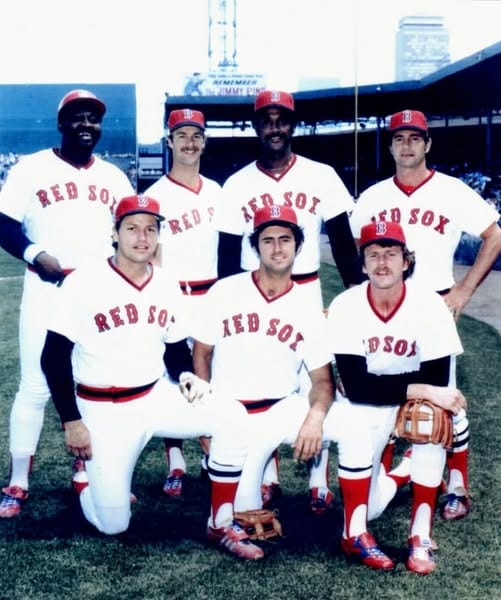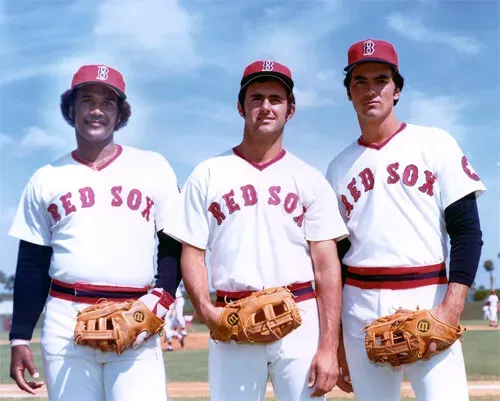Lynn, Fisk, Betts, Devers — A Tale of Two Red Sox Eras and the Same Mistakes
In 1981, the Red Sox let go of Lynn, Fisk, Burleson, and Hobson. In 2025, it’s Betts, Bogaerts, and Devers. Two generations of homegrown stars, the same painful mistake — and a fan base still asking why.

How the franchise let go of its homegrown core in 1981 — and again in 2025.
Red Sox fans are enraged.
They’ve watched two homegrown, potential Hall of Famers — Mookie Betts and now Rafael Devers — traded away in the prime of their careers. To make matters worse, the return has been underwhelming, bordering on nothing. The front office feels dysfunctional, or at the very least, not “aligned.”
Ownership seems more concerned about profitability than championships. And for many fans, that’s where the doubt begins to fester: Do they even care about winning anymore? Do they care about me – the fan?
For me, though, this isn’t new.
I’ve been here before.
The year was 1981.
Just a few years earlier, the Red Sox had reached the World Series in 1975. From 1977 to 1979, they won 97, 99, and 91 games — a dominant stretch by any standard.
Of course, times were different then. Not as many teams made the playoffs. But despite falling short of October baseball during that run, the feeling in Boston was clear: this team was on the verge of ending “The Curse.”
The core was young, homegrown, and just hitting its prime.
They had one of the best young outfields in baseball.

Jim Rice was just 25 when he won the American League MVP in 1978, nearly claiming the Triple Crown with 46 home runs, 139 RBI, and a .315 batting average. He was proving himself a worthy successor to Ted Williams and Carl Yastrzemski in left field. No one played The Wall better. Everyone remembers Rice’s power, but few recall how many times he would hit the ball into The Triangle in Fenway's right center field – his 15 triples in 1977 and 1978 were a testament to it.
Fred Lynn had won the AL MVP and Rookie of the Year in 1975 at just 23 years old. In 1979, he blasted 39 home runs, drove in 122 runs, and led the league with a .333 batting average. I loved everything about Lynn, but what made him my favorite player was the way he played center field — smooth and graceful, yet fearless. He won four Gold Gloves with the Red Sox, including one as a rookie, and played like every fly ball belonged to him.
In right field, Dwight Evans was just beginning to come into his own as a hitter, but his defense was already elite. No one has ever played right field at Fenway better than Dewey. By 1980, he had won three Gold Gloves, and his throwing arm was feared across the league. That year, he led all outfielders with seven double plays — a stat that only hints at how many runners thought twice about challenging him.
The left side of the infield featured third baseman Butch Hobson and shortstop Rick “Rooster” Burleson — two players who embodied the blue-collar identity of those Red Sox teams.
Burleson had the strongest arm of any Red Sox shortstop I’ve seen in my lifetime. In 1980, at age 29, he led all AL shortstops with 301 putouts, 528 assists, and 147 double plays. He was a defensive anchor and a fiery competitor — the kind of player you wanted on your side in a fight. He earned a Gold Glove in 1979, but his value went far beyond awards. He was the heart of the team.
Hobson, meanwhile, was only 25 when he slugged 30 home runs in 1977. He had Paul Newman looks and played with reckless intensity. Yes, he was erratic in the field — especially as injuries piled up — but I still remember the diving stops, the hustle, the toughness. He may not have been a superstar, but he took pride in representing Boston.
And then there was Carlton Fisk — “The Captain.” If you were going to build a catcher in a laboratory, the result would be Fisk. He won Rookie of the Year in 1972, was a perennial All-Star, and in the 1975 World Series, he hit the most iconic home run in franchise history — the Game Six walk-off, waving it fair as it clanged off the left-field foul pole at Fenway. Behind the plate, he was as tough and smart as anyone in the game; in 1978, he recorded 90 assists, gunning down baserunners and commanding the field like a general.
It was an incredibly likable, blue-collar team — tough, talented, and totally Boston. They didn’t just represent the city. They were the city.
But then Haywood Sullivan happened.
Sullivan had spent less than a year as general manager of the AFL’s Boston Patriots in the mid-1960s before turning back to baseball. He joined the Red Sox front office in 1966, and by 1977, he had positioned himself to take over as the team’s general manager.
That same year, the Red Sox parted ways with Dick O’Connell, who had served as GM since 1965 and was widely credited as the architect of the teams that reached the World Series in 1967 and 1975. His firing in November 1977 was controversial — not because of his performance, but because of politics.
When longtime owner Tom Yawkey died in 1976, control of the franchise passed to a three-person trust: Yawkey’s widow, Jean, and two front-office executives — Sullivan and Buddy LeRoux. With Yawkey gone, Sullivan seized control of baseball operations and forced O’Connell out.
Sullivan had always coveted the general manager’s job, and once he was in charge — with Tom Yawkey no longer around to stop him — he fired O’Connell for no reason other than he wanted the job for himself.
And almost immediately, he began dismantling the 1975 World Series team.
In June 1978, he traded fan favorite Bernie Carbo to the Cleveland Indians. Carbo wasn’t a superstar, but he was beloved — the kind of clutch, quirky hitter fans rallied around. Just three years earlier, he’d hit the game-tying home run in Game 6 of the ’75 World Series, setting the stage for Fisk’s iconic walk-off.
Then in December 1978, Sullivan traded lefty pitcher Bill Lee to the Montreal Expos for infielder Stan Papi — who would go on to hit just .188 in 1980. Lee had clashed with manager Don Zimmer and was considered a “bad influence” on younger players, but to fans, he was something more: a counterculture icon, a free spirit, and one of the most unique personalities to ever wear a Red Sox uniform. Even today, Lee still pitches competitively in his seventies — a testament to his love of the game. His departure, like Carbo’s, signified ownership's dissatisfaction with the culture of the team.
Then came the 1980–81 offseason — the one that broke me as an 11-year-old.
In December 1980, Sullivan traded Rick “The Rooster” Burleson and Butch Hobson — the emotional leader and the gritty third baseman with Paul Newman looks — to the California Angels.
In return for two cornerstone players, the Red Sox got an injection of youth and promise. Third baseman Carney Lansford, 23, made an immediate impact and even won a batting title in the strike-shortened 1981 season. But he was gone within two years, replaced by Wade Boggs, who had inexplicably been buried in the minors for too long. Reliever Mark Clear, 24, had a few solid seasons, but didn't last long in Boston. The third piece, Rick Miller, 32, was a familiar face — he’d played in Boston from 1971 to 1977 — but by then, he was primarily a defensive replacement and a pinch-hitter (a very good one, at that – he had 15 pinch-hits in 1983).
The Sox had traded the heart of their team for prospects and an over-the-hill veteran. It felt like the team was transforming, needlessly, to satisfy one person's vision. The team no longer belonged to Boston.
It belonged to Haywood Sullivan.
Rick Burleson may not have worn a “C” on his jersey, but make no mistake — he was the Red Sox’ captain in every way that mattered. Tough, vocal, and fiercely loyal, “The Rooster” set the tone in the clubhouse and on the field. Losing him wasn’t just about talent. It was about the team's identity.
Butch Hobson wasn’t a superstar either, but he symbolized Boston just the same. He bled for the Red Sox — literally — playing through an elbow injury that left him barely able to throw, diving after balls like his body didn’t matter. When the team traded him along with Burleson, it wasn’t just a roster move. It was a message: the team was headed in a different direction.
But the worst was yet to come.
Carlton Fisk — the face of the franchise, the soul of Fenway, and the man who had waved the most iconic home run in Red Sox history fair — wasn’t traded. He was lost through sheer negligence.
In the winter of 1980, the front office failed to mail his contract on time, postmarking it one day late — a clerical error that made him a free agent by rule. And rather than fight to keep him, the Red Sox let him test the free agent market.
Carlton Fisk signed with the Chicago White Sox, where he would go on to play another 13 seasons and earn his place in Cooperstown.
But before that long run began, he made his point. On Opening Day 1981, in his first game against the Red Sox, at Fenway Park, Fisk launched a three-run homer over the Green Monster off Bob Stanley — a towering, emotional punctuation mark on the failure that let him go.
Carlton Fisk homers on Opening Day in 1981 in his first game against Boston after signing with the White Sox.
To fans, it wasn’t just a paperwork error. It was a gut punch. Losing a generational catcher over a late envelope didn’t feel like bad luck — it felt like betrayal. And it exposed a level of dysfunction and indifference that no apology could fix.
As if losing Fisk weren’t enough, just weeks later, Fred Lynn was gone too.
The smooth-swinging center fielder — Rookie of the Year and MVP in 1975 — had been a cornerstone of the franchise’s future… or so fans believed. But instead of building around one of the game’s most complete players, the Red Sox, again, fumbled contract negotiations and traded him to the California Angels in January 1981. Lynn wanted to stay. He loved Boston. But like Fisk, he was made to feel expendable. The return — a fading Frank Tanana and spare parts — only deepened the sting.
In the span of one brutal offseason, the Red Sox lost their heart (Fisk), their soul (Burleson), their grit (Hobson), and their grace (Lynn).
It wasn’t just a teardown.
It was a slap in the face to the fans.
More than forty years later, the names have changed, but the heartbreak feels eerily familiar.
Mookie Betts, like Lynn before him, was a homegrown MVP — a five-tool superstar who could have been the face of the franchise for a generation. But instead of committing to him, the Red Sox traded him in his prime for a package that never came close to matching his value. Just months later, Betts helped lead the Dodgers to a World Series title, while Boston was left to second guess their decision.
Xander Bogaerts, a two-time World Series champion and the clubhouse’s emotional center, was allowed to walk — not because he didn’t want to be here, but because the team wouldn’t match dollars and years.
And now, Rafael Devers — the last of that dynamic trio — has been traded too.
Red Sox President and CEO Sam Kennedy and Chief Baseball Officer Craig Breslow may try to frame the dismantling of this once-promising core — Betts, Bogaerts, and now Devers — as a necessary step toward reshaping the culture or doing what’s best for the franchise. But fans aren’t buying it.
From the outside, it doesn’t look strategic or visionary — it looks cheap and reactionary. It looks like ownership once again prioritizing profits over winning, just as they did in the Jean Yawkey–Sullivan–LeRoux era. The team feels rudderless. The front office feels fractured.
The names and faces may be different, but the pain — and the betrayal — feel the same.
In 1981, it was Lynn, Fisk, Burleson, and Hobson — the heart and soul of a Red Sox team that felt destined for greatness.
In 2025, it’s Betts, Bogaerts, and Devers — a new generation of homegrown stars cast aside in the name of fiscal responsibility and organizational alignment.
Both times, fans were told to trust the front office.
Both times, they’ve been left with the same thing: “what ifs.”
History wasn’t supposed to repeat itself.
But here we are — more than forty years later — watching the same kinds of missteps drive a wedge between the Red Sox and the fans who have stood by them through it all.
The heartbreak of losing Betts, Bogaerts, and Devers echoes what happened with Lynn, Fisk, and Burleson — and it’s left many wondering if the organization has truly learned from its past.
But maybe — just maybe — there’s still time to get it right.
With a promising wave of young talent arriving at the major league level — Roman Anthony, Marcelo Mayer, Kristian Campbell, Ceddanne Rafaela — the Red Sox have another chance. Another chance to value their homegrown core.
To build around, and not dismantle.
The names may be different, but the opportunity is the same.
Let’s hope this time, they don’t waste it.
📣 Share This Article
Think a fellow Sox fan would appreciate this story? Share it:
